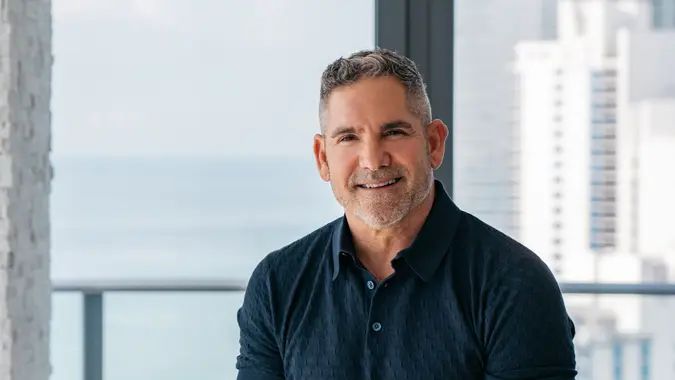4 Top Fears of Middle-Class Retirees — and How To Avoid Them

Commitment to Our Readers
GOBankingRates' editorial team is committed to bringing you unbiased reviews and information. We use data-driven methodologies to evaluate financial products and services - our reviews and ratings are not influenced by advertisers. You can read more about our editorial guidelines and our products and services review methodology.

20 Years
Helping You Live Richer

Reviewed
by Experts

Trusted by
Millions of Readers
Middle-class retirees face specific anxieties that keep them up at night. And here’s the thing: They’re not unreasonable for doing so. Every fear listed below has a basis in current events. The risks are real as money gets tighter for the beleaguered American middle class.
Now for the good news: Anyone dreading the future can relax a bit. With proper planning, there are ways to safeguard your financial standing. Two financial experts explained the biggest retirement fears and provided concrete strategies for addressing each one.
Outliving Your Savings
Dr. Robert R. Johnson, professor of finance at Creighton University’s Heider College of Business, cited research showing this as the top concern.
“According to the Transamerica Center for Retirement Studies, the top fear of people aged 50 and over, 43% said their greatest fear was outliving savings and investment,” Johnson said.
Ben Waterman, CEO of Strabo, called this “longevity risk” and said it’s “the biggest fear.”
How to avoid it: Both experts recommended creating guaranteed income streams. Johnson advocated for annuities despite their controversial reputation.
“Annuities are an important part of a comprehensive retirement plan,” he said. “Annuities too often get a bad rap. They can provide guaranteed income and peace of mind to the retiree.”
Johnson specifically recommended using annuities strategically. “Having an annuity cover your basic living expenses is a terrific cornerstone to a retirement income plan. In particular, a longevity annuity is a stream of payments that starts when an individual reaches a certain age — say 85. If you have a longevity annuity, you have a secure source of income late in your life at a reasonable cost.”
Waterman offered a broader approach: “You can mitigate this by creating guaranteed income streams, either with pensions/annuities or systematic withdrawal plans that will cover your expenses for life.”
The key is ensuring your essential expenses are covered by guaranteed income sources (think, Social Security, pensions, annuities) so market volatility can’t force you into poverty.
Rising Healthcare Costs
Next up?
“Second (38%) was declining health that requires long-term care,” Johnson said, again citing the Transamerica Center for Retirement Studies.
Waterman agreed that this ranks high among middle-class retiree concerns.
How to avoid it: Waterman acknowledged the difficulty of preserving one’s health, but he provided a two-part strategy. “This is a bit more tricky. It can be tackled by building a dedicated savings buffer and with long-term health insurance.”
Long-term care insurance purchased in your 50s or early 60s costs significantly less than policies bought later. A dedicated healthcare savings account separate from general retirement funds prevents one medical crisis from derailing your entire retirement plan.
The combination of insurance coverage and earmarked savings protects from the catastrophic costs of long-term care needs that can destroy retirement security.
Market Volatility Destroying Portfolio Value
Waterman identified market volatility as a major middle-class retiree fear, particularly the risk of being forced to sell investments during downturns to cover costs.
How to avoid it: Waterman recommended time-based planning. “This can be tackled by planning three to five years ahead and keeping this amount of living expenses in conservative assets that will help avoid you selling in a downturn.”
The strategy involves maintaining three to five years of living expenses in bonds, CDs and other conservative investments that won’t crash alongside stocks. When markets drop, you draw from these conservative holdings rather than selling stocks at losses.
This approach allows your stock portfolio to recover during market downturns without forcing you to lock in losses by selling at the worst possible time. Once markets recover, you replenish the conservative bucket from stock gains. The peace of mind from knowing you can weather a years-long bear market without touching stocks is enormous for retirees who remember 2008 or 2020 market crashes.
Unexpected Expenses or Family Support Needs
Waterman called out unexpected expenses and family support obligations as a significant retirement fear that retirees often overlook in basic planning.
Adult children needing financial help, grandchildren’s education costs, home repairs, family emergencies: These unpredictable costs derail retirement plans that only account for expected expenses.
How to avoid it: Waterman recommended robust emergency funds. “This is where your emergency fund with ideally six months but ideally more is kept completely liquid in cash or cash equivalents.”
Most financial advice suggests three to six months of expenses in emergency funds. Waterman pushed for more in retirement because recovering from financial setbacks becomes harder without employment income.
The emergency fund sits separate from the three- to five-year conservative holdings for market volatility protection. One protects against market timing risk, the other protects against daily life’s unpredictability. Keeping these funds “completely liquid in cash or cash equivalents” means high-yield savings accounts or money market funds, not investments that could lose value when you need them most.
 Written by
Written by  Edited by
Edited by 























